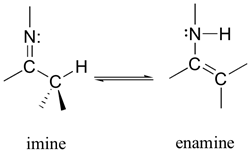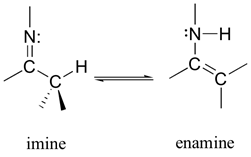
Organic Chemistry Study Guide and Solutions Manual, Books a la Carte Edition (8th Edition)
8th Edition
ISBN: 9780134649771
Author: Paula Yurkanis Bruice
Publisher: PEARSON
expand_more
expand_more
format_list_bulleted
Question
Chapter 16.8, Problem 32P
(a)
Interpretation Introduction
Interpretation:
The mechanisms for the following reactions should be determined.
- 1. The acid-base catalyzed hydrolysis of an imine to a carbonyl compound and a primary
amine . - 2. The acid-base catalyzed hydrolysis of an enamine to a carbonyl compounds and a secondary amine.
Concept introduction:
The chemical compound containing carbon and nitrogen double bond is known as imine.
Enamine is derived by the condensation of an

(b)
Interpretation Introduction
Interpretation:
The reason for the difference in mechanism of two reactions should be given.
Concept introduction:
The chemical compound containing carbon and nitrogen double bond is known as imine.
Enamine is derived by the condensation of an aldehyde and ketone with secondary amine.

Expert Solution & Answer
Want to see the full answer?
Check out a sample textbook solution
Students have asked these similar questions
&
Calculate the molar enthalpy of combustion (A combH) of 1.80 g of pyruvic acid
(CH3COCOOH; 88.1 g mol-1) at 37 °C when they are combusted in a calorimeter at
constant volume with a calorimeter constant = 1.62 kJ °C-1 and the temperature rose
by 1.55 °C. Given: R = 8.314 J mol −1 °C-1 and the combustion reaction:
AN
C3H4O3 + 2.502(g) → 3CO2(g) + 2H2O(l)
An unknown salt, AB, has the following precipitation reaction:A+(aq) + B-(aq) ⇌ AB(s) the K value for this reaction is 4.50 x10-6. Draw a model that represents what will happen when 1.00 L each of 1.00 M solution of A+(aq) and 1.00M solution of B-(aq) are combined.
5.
a) Use the rules in Example 4.4 (p. 99) and calculate sizes of octahedral and tetrahedral
cavities in titanium and in zirconium. Use values for atomic radii given in Fig. 9.1 (p.291).
(3 points)
b) Consider the formation of carbides (MC) of these metals. Which metal is able to
accommodate carbon atoms better, and which cavities (octahedral or tetrahedral) would be better
suited to accommodate C atoms into metal's lattice?
(4 points)
Chapter 16 Solutions
Organic Chemistry Study Guide and Solutions Manual, Books a la Carte Edition (8th Edition)
Ch. 16.1 - Give two names for each of the following:Ch. 16.1 - Prob. 2PCh. 16.1 - Name the following:Ch. 16.2 - Prob. 4PCh. 16.4 - What products are formed when the following...Ch. 16.4 - We saw on the previous page that...Ch. 16.4 - a. How many stereoisomers are obtained from the...Ch. 16.4 - Prob. 9PCh. 16.4 - Write the mechanism for the reaction of acetyl...Ch. 16.4 - Prob. 11P
Ch. 16.4 - Show how the following compounds can be...Ch. 16.4 - Prob. 13PCh. 16.4 - Prob. 14PCh. 16.4 - In the mechanism for cyanohydrin formation, why is...Ch. 16.4 - Prob. 16PCh. 16.4 - Prob. 17PCh. 16.4 - Show two ways to convert an alkyl halide into a...Ch. 16.5 - Prob. 20PCh. 16.5 - Prob. 21PCh. 16.5 - Prob. 22PCh. 16.5 - Prob. 23PCh. 16.6 - Prob. 24PCh. 16.7 - What reducing agents should be used to obtain the...Ch. 16.7 - Prob. 26PCh. 16.8 - Prob. 27PCh. 16.8 - Prob. 28PCh. 16.8 - Prob. 29PCh. 16.8 - The pKa of protonated acetone is about 7.5. and...Ch. 16.8 - Prob. 31PCh. 16.8 - Prob. 32PCh. 16.8 - Prob. 33PCh. 16.8 - Excess ammonia must be used when a primary amine...Ch. 16.8 - The compounds commonly known as amino acids are...Ch. 16.9 - Hydration of an aldehyde is also catalyzed by...Ch. 16.9 - Which ketone forms the most hydrate in an aqueous...Ch. 16.9 - When trichloroacetaldehyde is dissolved in water,...Ch. 16.9 - Which of the following are a. hermiacetals? b....Ch. 16.9 - Prob. 40PCh. 16.9 - Explain why an acetal can be isolated but most...Ch. 16.10 - Prob. 42PCh. 16.10 - Prob. 43PCh. 16.10 - What products would be formed from the proceedings...Ch. 16.10 - a. In a six-step synthesis, what is the yield of...Ch. 16.10 - Show how each of the following compounds could be...Ch. 16.12 - Prob. 47PCh. 16.13 - Prob. 49PCh. 16.14 - Prob. 50PCh. 16.15 - Prob. 51PCh. 16.16 - Prob. 52PCh. 16 - Draw the structure for each of the following: a....Ch. 16 - Prob. 54PCh. 16 - Prob. 55PCh. 16 - Prob. 56PCh. 16 - a. Show the reagents required to form the primary...Ch. 16 - Prob. 58PCh. 16 - Prob. 59PCh. 16 - Using cyclohexanone as the starting material,...Ch. 16 - Propose a mechanism for each of the following...Ch. 16 - Show how each of the following compounds can be...Ch. 16 - Fill in the boxes:Ch. 16 - Prob. 64PCh. 16 - Identify A through O:Ch. 16 - Prob. 66PCh. 16 - Prob. 67PCh. 16 - Prob. 68PCh. 16 - How many signals would the product of the...Ch. 16 - Prob. 70PCh. 16 - Prob. 71PCh. 16 - Prob. 72PCh. 16 - Prob. 73PCh. 16 - Prob. 74PCh. 16 - Prob. 75PCh. 16 - Prob. 76PCh. 16 - Prob. 77PCh. 16 - Prob. 78PCh. 16 - Draw structure for A-D for each of the following:Ch. 16 - Prob. 80PCh. 16 - a. Propose a mechanism for the following reaction:...Ch. 16 - Prob. 82PCh. 16 - A compound gives the following IR spectrum. Upon...Ch. 16 - How can be following compounds be prepared from...Ch. 16 - Prob. 85PCh. 16 - Prob. 86PCh. 16 - Prob. 87PCh. 16 - In the presence of an acid catalyst, acetaldehyde...Ch. 16 - Prob. 89PCh. 16 - Prob. 90PCh. 16 - Prob. 91PCh. 16 - A compound reacts with methylmagnesium bromide...Ch. 16 - Show how each of the following compounds can be...Ch. 16 - Prob. 94PCh. 16 - The pKa values of the carboxylic acid groups of...Ch. 16 - The Baylis-Hillman reaction is a DABCO...Ch. 16 - Prob. 97PCh. 16 - Prob. 98P
Knowledge Booster
Similar questions
- 2. Read paragraph 3.4 in your textbook ("Chiral Molecules"), and explain if Cobalt(ethylenediamine) 33+ shown in previous problem is a chiral species. If yes, draw projections of both enantiomers as mirror images, analogous to mirror projections of hands (below). Mirror (4 points)arrow_forward3. Borane (BH3) belongs to D3h point group. Consider the vibrational (stretching) modes possible for B-H bonds under D3h symmetry. Using the methods we used in class, construct the reducible representation I, and break it down into irreducible representations using the character table provided. Sketch those modes, indicate whether they are IR-active. (6 points) D3h E 2C3 3C2 σh 283 30% A₁' 1 1 1 1 1 1 x² + y², z² 1 -1 1 1 -1 R₂ E' 2 0 2 0 (x, y) (x² - y², xy) " A₁" 1 1 -1 A2" 1 -1 -1 1 Z E" 2 -1 0 -2 1 0 (Ry, Ry) (xz, yz)arrow_forward1. List all the symmetry elements, and assign the compounds to proper point groups: a) HCIBrC-BrCIH Cl Br H (2 points) H Br b) Pentacarbonylmanganese(I)bromide Br OEC-Mn-CEO 00- c) Phenazine (aromatic molecule, with delocalized bonding) 1 d) Cobalt(ethylenediamine)33+ (just the cation) 3+ H₂N H₂ .NH2 (CI)3 NH2 H2 H₂N. (2 points) (2 points) (2 points)arrow_forward
- Hello, I desperately need help figuring out 8-14; I also wanted to see if you would mind letting me know if I picked the right degree as my melting points on the two graphs. Please and thank you in advance! All the information is provided.arrow_forwardThe reaction: A + B ⇌ 2 C, can be represented by the equilibrium expression, KC =[C]2[A][B]=258 at 520K.When 1.00 M of C was allowed to reach equilibrium and 0.055 M of A was formed. If this reaction wasperformed at the same temperature using 0.500 M C, what would the equilibrium concentration of Abe?arrow_forward1. What is the functional group of an alcohol and a phenol? 2. Why are some alcohols soluble in water? 3. Classify each of the following alcohols as primary, secondary or tertiary. a. 3-pentanol b. 2-methyl-2-butanol c. 1-propanolarrow_forward
- I need help with B2 using the information in B1. This is for my lab notebook, and I got confused on number 2. Please help.arrow_forward4. Aluminum has a face-centered cubic structure. The unit cell length is 4.05Å. Calculate the radius of Al atom in the metal. (5 points).arrow_forwardHF and HNO2 are both considered weak acids. Given the following K values for their dissociationequations, which is the weaker of these two weak acids?HF (aq) ⇌ H+(aq) + F –(aq) K=6.6 x10-4 HNO2 (aq) ⇌ H+(aq) + NO2–(aq) K=7.2 X 10-4arrow_forward
- The equilibrium constant for this reaction is 5.88 x 104. If concentration of the lead ion is 5.24 M, whatis the concentration of the chloride ion?Pb2+(aq) + 2 Cl- (aq) ⇌ PbCl2(s)arrow_forwardc. 1-propanoi 4. If you add chromate, an oxidizing agent, to each of the following, would a green Cr3+ solution be formed? a. 3-pentanol b. 2-methyl-2-butanol c. 1-propanol 5. If an alcohol solution has a pH of 5, would it be a primary alcohol, a secondary alcohol, a tertiary alcohol, or a phenol?arrow_forwardGiven the reaction: A(aq) + B(aq) ⇌ 2C(aq) + D(aq). 2.00 moles of each reactant were dissolved into 1.00 literof water. The reaction reached equilibrium, and at equilibrium the concentration of A was 1.60 M.A) Calculate the equilibrium concentrations for each substance. B) Write the equilibrium constant expression. C) Calculate the value for the equilibrium constant, Keq.arrow_forward
arrow_back_ios
SEE MORE QUESTIONS
arrow_forward_ios
Recommended textbooks for you
 Organic Chemistry: A Guided InquiryChemistryISBN:9780618974122Author:Andrei StraumanisPublisher:Cengage Learning
Organic Chemistry: A Guided InquiryChemistryISBN:9780618974122Author:Andrei StraumanisPublisher:Cengage Learning Organic ChemistryChemistryISBN:9781305580350Author:William H. Brown, Brent L. Iverson, Eric Anslyn, Christopher S. FootePublisher:Cengage Learning
Organic ChemistryChemistryISBN:9781305580350Author:William H. Brown, Brent L. Iverson, Eric Anslyn, Christopher S. FootePublisher:Cengage Learning
 Chemistry for Today: General, Organic, and Bioche...ChemistryISBN:9781305960060Author:Spencer L. Seager, Michael R. Slabaugh, Maren S. HansenPublisher:Cengage Learning
Chemistry for Today: General, Organic, and Bioche...ChemistryISBN:9781305960060Author:Spencer L. Seager, Michael R. Slabaugh, Maren S. HansenPublisher:Cengage Learning

Organic Chemistry: A Guided Inquiry
Chemistry
ISBN:9780618974122
Author:Andrei Straumanis
Publisher:Cengage Learning

Organic Chemistry
Chemistry
ISBN:9781305580350
Author:William H. Brown, Brent L. Iverson, Eric Anslyn, Christopher S. Foote
Publisher:Cengage Learning


Chemistry for Today: General, Organic, and Bioche...
Chemistry
ISBN:9781305960060
Author:Spencer L. Seager, Michael R. Slabaugh, Maren S. Hansen
Publisher:Cengage Learning